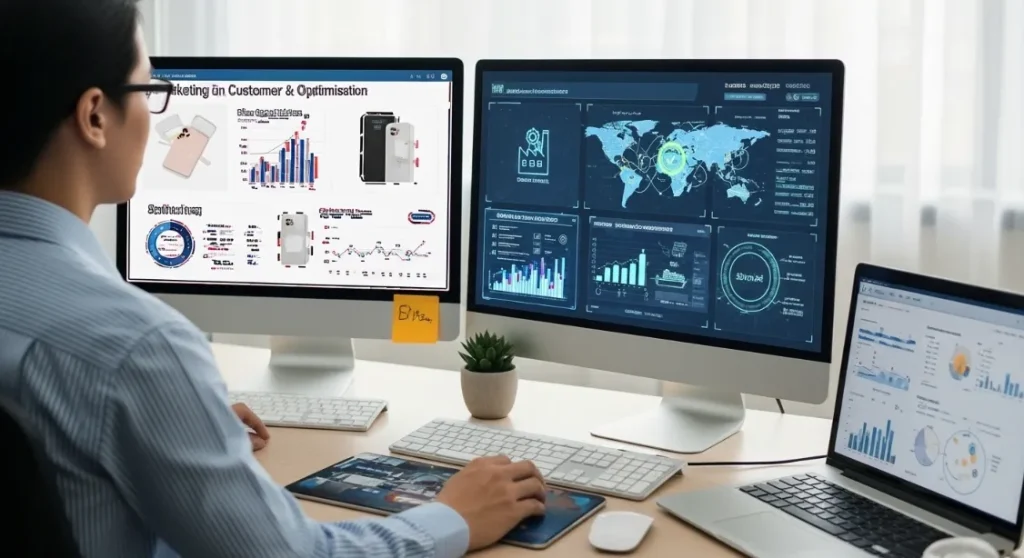Unlike seasonal niches, smartphones offer consistent, recurring demand. Users regularly upgrade devices and continuously purchase accessories like cases, chargers, and screen protectors. This predictable demand cycle makes smartphone dropshipping one of the most stable e-commerce niches.
This guide reveals proven smartphone dropshipping profit strategies for your business. You’ll discover how to select high-margin products, optimize pricing for maximum profit, build reliable supplier relationships, and scale using data-driven decisions.
Explore our Profit Margin Calculator
Strategic Product Selection for Maximum Profitability

High-Demand Accessories with Strong Margins
Focus on these proven categories for consistent profits:
Screen Protectors
- 40-60% profit margins
- Repeat purchase cycle every 6-12 months
- Universal demand across all devices
Phone Cases
- Highest differentiation potential
- 30-50% margins on unique designs
- Strong visual appeal for social media marketing
Wireless Charging Accessories
- Growing adoption rate
- 35-55% margins
- Cross-compatible with multiple devices
Portable Power Banks
- Consistent year-round demand
- 25-40% margins
- Appeals to travelers and commuters
Car Mounts and Holders
- Practical necessity
- 30-45% margins
- Low return rates
Spotting Emerging Trends
Monitor these sources for early trend identification:
- Tech publication reviews of new phone launches
- Kickstarter/Indiegogo trending projects
- Social media hashtag analysis (#phoneaccessories, #tech)
- Google Trends for rising search terms
Pro Tip: Position inventory 6-8 weeks before major phone launches. New device releases create immediate demand for compatible accessories.
Quality Assessment Criteria
Electronics require stricter vetting than typical dropshipped products:
- Certifications: Verify CE, FCC, and RoHS compliance
- Component authenticity: Check battery cell brands and chipset specifications
- Durability testing: Request drop-test videos for protective cases
- Accurate specifications: Confirm wattage ratings for chargers, mAh capacity for power banks
Always order samples and test for minimum one week before listing products.
Pricing Strategies That Maximize Conversions

Psychological Pricing Techniques
Charm Pricing: Use $29.97 instead of $30.00 to increase conversions by up to 7%
Three-Tier Strategy: Present basic, plus, and premium options to guide customers toward mid-tier products with optimal margins
Scarcity Messaging: “Limited stock for new iPhone 15 cases” creates urgency and justifies premium pricing
Bundle Pricing for Higher Order Values
Create compelling accessory bundles:
New Phone Protection Kit: Case + screen protector + cleaning cloth
- Individual pricing: $39.97
- Bundle price: $34.97
- Higher perceived value, improved margins
Travel Essentials: Power bank + car charger + cable organizer
- Targets specific use cases
- Increases average order value by 25-35%
Browse Uniqbe smartphone catalogue
Dynamic Pricing Strategy
Use repricing tools for commodity items like cables and basic chargers. For unique accessories, maintain static pricing with strategic promotional periods.
Market-Based Adjustments:
- Commodity accessories: 20-30% margins
- Differentiated products: 30-45% margins
- Premium/unique items: 45%+ margins
Building Reliable Supplier Networks

Supplier Vetting Checklist
Documentation Verification:
- Business licenses and certifications
- Factory photos and capabilities
- Trade assurance ratings above 95%
- Minimum 2 years operating history
Quality Assurance:
- Request product samples for all new SKUs
- Verify 30-day average shipping times
- Check customer review ratings (minimum 4.0/5.0)
- Confirm warranty and return policies
Negotiation Strategies
Volume-Based Discounts: Commit to monthly order minimums for 3-5% price reductions
Payment Terms: Offer faster payment (7-day terms vs. 30-day) for better pricing
Exclusive Arrangements: Negotiate first access to new products in exchange for marketing commitments
Quality Control Implementation
Pre-Shipment Protocols:
- Photo confirmation for orders over $50
- Third-party inspections for bulk orders
- Functionality testing checklist for electronic items
Return Management:
- Establish clear warranty terms (12-month minimum)
- Create streamlined replacement procedures
- Maintain backup suppliers for popular products
Marketing and Customer Acquisition Optimization

Social Media Marketing Focus
Platform-Specific Strategies:
TikTok/Instagram Reels: Product demonstration videos showing durability tests, before/after protection comparisons
Instagram Posts: Lifestyle shots featuring accessories in real-world scenarios
Facebook Ads: Detailed targeting based on phone model ownership and accessory purchase history
SEO for Product Pages
Long-Tail Keywords: Target specific searches like “wireless charger for iPhone 15 Pro Max” or “waterproof case Samsung Galaxy S24”
Technical Optimization:
- Mobile-first responsive design
- Page load speeds under 3 seconds
- Structured data markup for product information
- Customer review integration
Email Marketing Automation
Segmented Campaigns:
- New device launch announcements to customers with compatible phones
- Seasonal promotions (back-to-school, holiday gifting)
- Abandoned cart recovery sequences
Performance Metrics: Target 15-25% open rates and 2-4% click-through rates for accessory promotions
Operational Excellence and Cost Reduction
Order Processing Automation
Implement automated systems connecting your store to supplier APIs. This eliminates manual order entry and reduces processing time from hours to minutes.
Recommended Tools:
- DSers for AliExpress integration
- Spocket for faster shipping suppliers
- AutoDS for multi-platform management
Inventory Management
Stock Level Automation:
- Set automatic product removal when supplier inventory drops below 10 units
- Enable low-stock notifications 48 hours before stockouts
- Maintain backup suppliers for top 20% of products by revenue
Customer Service Efficiency
Self-Service Resources:
- Comprehensive FAQ covering compatibility questions
- Video installation guides for complex accessories
- Clear return and warranty procedures
Response Time Targets:
- Live chat: Under 2 minutes
- Email inquiries: Within 4 hours
- Return processing: 24-48 hours
Data-Driven Scaling Strategies
Essential KPIs to Monitor
Daily Metrics:
- Conversion rate by product category
- Average order value trends
- Customer acquisition cost by channel
Weekly Analysis:
- Product performance rankings
- Supplier delivery performance
- Return rate by product type
Monthly Reviews:
- Customer lifetime value calculation
- Profit margin analysis by category
- Market trend assessment
A/B Testing for Optimization
Product Page Elements to Test:
- Hero image selection (lifestyle vs. product-only shots)
- Pricing display format ($29.99 vs. $29.97)
- Call-to-action button colors and text
- Customer review placement and format
Testing Protocol: Change one element at a time with minimum 1,000 visitors per variation for statistical significance.
Conversion Rate Optimization
Key Improvements:
- Add compatibility charts for easy device matching
- Include unboxing and installation videos
- Display security badges and certifications
- Implement exit-intent popups with discount offers
Target Metrics:
- Overall conversion rate: 2-4%
- Mobile conversion rate: 1.5-3%
- Return visitor conversion: 4-8%
Future-Proofing Your Smartphone Business
Emerging Technology Trends
Next-Generation Accessories:
- MagSafe-compatible wireless charging stations
- Modular phone grip systems
- AR-enhanced phone photography accessories
- Fast-charging solutions for new battery technologies
Building Customer Loyalty
Brand Differentiation Strategies:
- Custom packaging with branded inserts
- Extended warranty programs
- Priority customer support for repeat buyers
- Exclusive access to new product launches
Risk Mitigation
Diversification Approach:
- Multiple suppliers per popular product
- Geographic supplier distribution (Asia, EU, US)
- Balanced inventory across price tiers
- Seasonal demand planning
Conclusion
Smartphone dropshipping offers exceptional profit potential when executed strategically. Success requires focusing on high-margin accessory categories, maintaining quality standards, and continuously optimizing based on performance data.
Start with these immediate actions:
- Audit your current product mix for margin optimization
- Implement automated order processing
- Test bundle pricing on your top 5 products
- Establish quality control protocols with suppliers
The smartphone market’s consistent growth and accessory demand cycles create sustainable business opportunities. Focus on building efficient operations and strong supplier relationships before expanding your product range.
Ready to optimize your smartphone dropshipping profits? Contact us now for top 10 products with conversion rates and profit margins. Small improvements in these areas compound into significant revenue growth over time.

 Hot Articles
Hot Articles